Do you know, that designing an app is much different from developing it?
Casting a design for your educational app can be a difficult task, right?
Well, here we are with an educational app design guide to help you with the process of creating it successfully.
Let’s start with the journey of educational app design.
What are the Basics of App Design?
Before we proceed with the process of app design, you should be aware of the fundamentals related to it.
Shall we study the basics of app design?
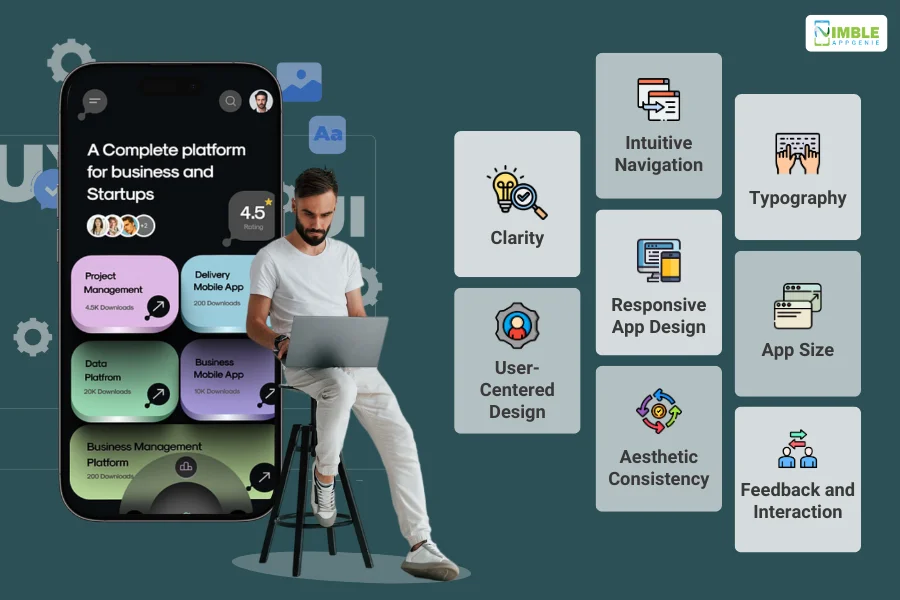
1. Clarity
It is important to have clarity of the topics and objectives that can be able to define the features and educational app ideas.
Clarity helps to bring transformity crucial to presenting a clutter-free design. A cluttered layout with high-contrast colors, complicated fonts, and texts can frustrate users.
2. User-Centered Design
To understand users, it is important to know the type of design they prefer. Users-centered design is completely an iterative procedure where designers focus on their needs.
It is a kind of framework where usability goals, environment, tasks, characteristics, and workflow are given extensive attention for each stage of the design procedure.
3. Intuitive Navigation
Intuitive navigation is an important procedure that guides visitors to the information for which they are looking and also helps them to understand the app.
Within the digital arena, intuitive navigation serves as a nucleus useful to shape user interaction along with the present path of websites and applications.
4. Responsive App Design
Responsive app design can be defined as a well-defined approach to the web that aims to make the web pages render over a variety of devices.
The primary goal of the responsive app design is to retain optimal usability along with appearance regardless of the device.
5. Aesthetic Consistency
It is a type of design where consistency is kept in notice. Consistency in the style and appearance of things assists the users in identifying the app and its navigation process.
Aesthetic Consistency is useful to make the app familiar by using a certain color theme, graphic design, and font.
6. Typography
A great-looking typography can attain the attention of large users and it has an entire look and feel of a mobile app.
Although these mobile apps rely on images and illustrations that attract the users quicker rather than texts.
7. App Size
There has been a lot of research conducted for people who are utilizing the app for common reasons.
EdTech app design generally relies on its size and the common features are accessible in thumb-regions. Here thumb regions refer to the easy accessibility of the users to operate the app with their thumb.
8. Feedback and Interaction
Feedback and interaction are important processes where apps collect feedback from the users and then implement them to improve their experience.
While using the platform, users expect to change the color or load a sub-menu as they want an instant response to what they have asked over there.
These were common basics for app design which are required to learn before heading toward their development.
Now, are you aware of building a good app design in educational apps?
Check out the next section below.
Importance of Good App Design in eLearning Apps
Prior to understanding what’s the popular and right design process for edtech app design, it is essential to note the importance of it.
Here is the list to follow.
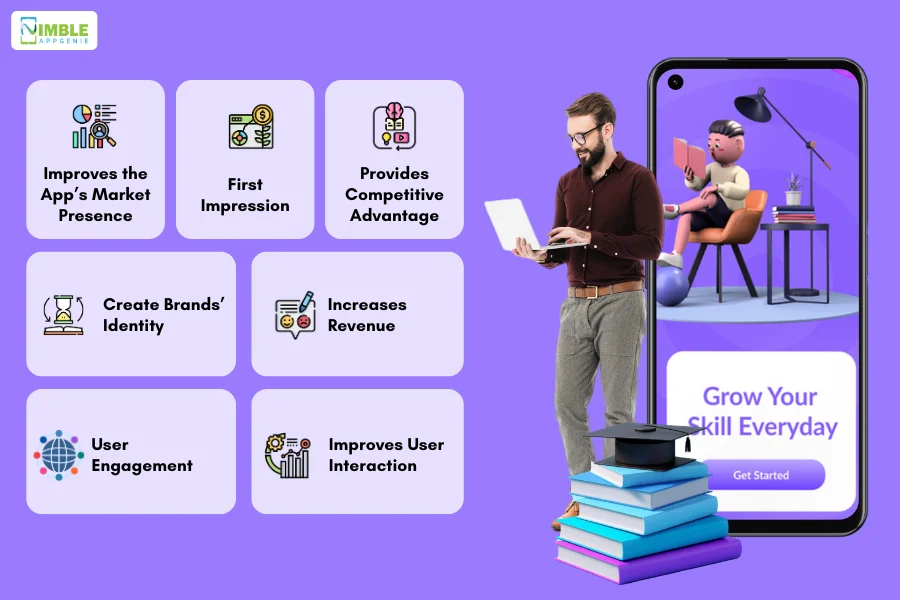
► Improves the App’s Market Presence
An app with good design is important for enhancing its market presence. A good design reduces friction which results in a better user experience and a higher rate of their conversion.
It offers a seamless user journey which ultimately boosts overall educational app performance. A great e-learning app UI design can increase its brand image in the competitive market.
► First Impression
First Impression is significant to make the educational app appealing for attracting users to download and use it appropriately.
Multiple factors matter when it comes to delivering effective first impressions through learning app design to the users including structure, colors, symmetry, text, fonts, and others.
► Provides Competitive Advantage
A good app design provides a competitive advantage within the crowded app market. When your educational app provides a superior user experience, it automatically makes it ahead of other competitors.
An effective educational app UI/UX design provides consistency that helps users recognize the brand easily. Thus, in the current era, a friendly app with familiar features can provide a competitive edge.
► Create Brands’ Identity
Effective user experience provides a consistent and visually appealing design that positively impacts the complete brand’s performance.
A brand that is capable of providing a good user experience improves the market presence of an educational app. A good eLearning app interface with a consistent pattern can build brand identity.
► Increases Revenue
The use of good design is capable of providing handsome revenue by providing users with a simple way to navigate through the app so that they can find an option to fulfill their demands.
A fulfilled user demand through the best educational app design can attract more users to the platform which also results in increasing sales and ultimately enhances ways to app monetization.
► User Engagement
An imperative and attractive UI/UX of the edtech app is built to engage users in the long run. A simple-to-use interface attracts more users to the platform and ultimately engages them over time.
Through fostering positive feedback and connection, user satisfaction can be achieved that engages them for the long term.
► Improves User Interaction
User interaction is one of the intangible parts to be considered while designing an educational app. A good design is essential to engage users and it improves interaction through direct communication.
With the help of personalized content, customized app settings, and location-based services, user interaction can increase.
These were some of the benefits of implementing a good design within the app. Till now, we have covered the basics of app design along with its importance for educational apps.
The next section provides details on popular educational app designs that can help you to select the best alternative from the bunch.
Top Popular Educational App Design for Inspiration
What’s the best design to create an educational App?
Well, design is an important element to be considered to create an educational app. However, to identify the best design for your app, it is vital to know the alternatives available to you.
Here is the list of popular app designs used by top educational apps.
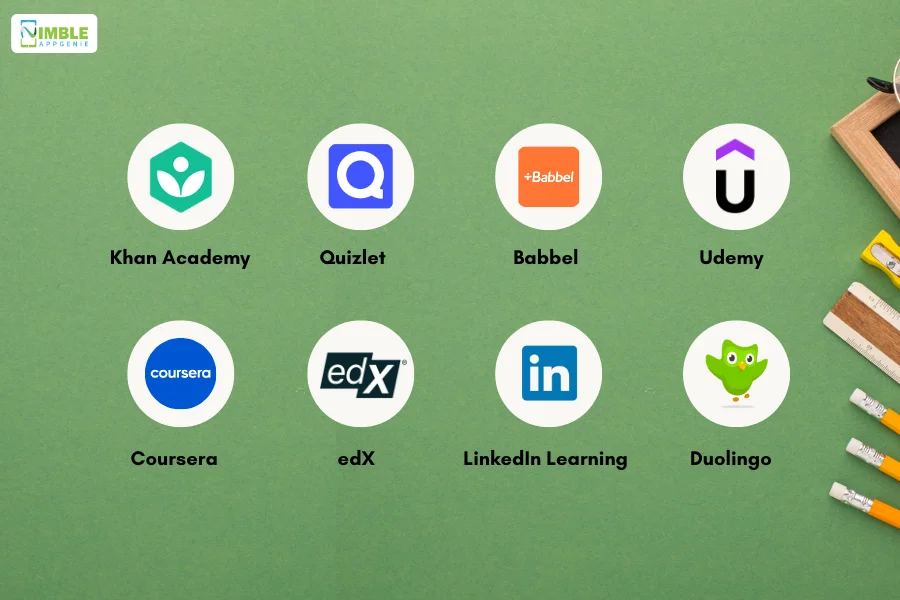
A] Khan Academy
An edtech app design requires features and a navigation process that is simple and easy to understand.
Khan Academy uses various tools including Camtasia recorder, smoothDraw, and Wacom Bamboo tablet which makes the platform attractive to invite new users.
Apart from these screen video recorders, and Microsoft Paint assists the users in drawing, painting, and performing various activities useful to improve learning.
B] Quizlet
Quizlet is an app focused on providing the right guidance to the students for learning. With effective educational app design features including infrastructure architecture, and visual design, they attract users.
The app is based on inspiring the students to learn important concepts and logic simply.
It uses tools including Figma, sketch, and others. You can make them a part of your app to increase its usability.
C] Babbel
Babbel uses an imperative design that contains proven cognitive techniques that process new vocabulary through the brain’s six memory stages.
The design of an educational app like Babbel relies on various types of screens including a login screen, home screen, splash screen, statistics screen, and others.
All you need is to design the type and number of screens for your app to select the right color and pattern. Develop an educational app like Babbel by deciding the right number of screens and types.
D] Udemy
Udemy works on the marketbase model where it connects with multiple sellers and buyers within the educational sector who sell their course or purchase one.
You can follow the best practices for educational app design by learning from the Udemy design pattern.
This app uses an interactive user interface design where viewers can purchase the course by scrolling, selecting, and tapping the lecture. Here users are allowed to the Udemy support for any issue or error they face.
Also Read: Create An e-Learning Platform Like Udemy
E] Coursera
Coursera is one the leading platforms in the educational app industry with its engaging feature where students take quizzes automatically and are graded accordingly.
Here users can find world-class learning from anywhere through its attractive user interface. They have designed wireframes and prototypes successfully to make the app competitive.
With a wide variety of tools, the platform was able to connect a variety of users across the world.
F] edX
edX is popular because it brings online courses from the world’s best universities and industry-leading companies to the users.
The educational app design is interactive, attractive, and scalable allowing users to draw and scale up their performance through learning.
edX uses the simplest ways to design edtech apps through Marvel, Figma, UXPin, etc. These tools help the platform to connect with the users successfully.
G] LinkedIn Learning
LinkedIn is one the top recruitment platform that entertains users finding jobs and businesses who seek skillful employees.
The platform LinkedIn Learning helps users enhance their skills and find potential jobs based on their portfolio. LinkedIn Learning uses the LIL interface for finding, storing content, and tracking the performance of the user.
The user interface of an educational app like LinkedIn Learning is based on providing a seamless experience by using the LIL interface that contains three parts including my learning page, LIL toolbar, and LIL homepage.
H] Duolingo
Duolingo app’s design is an important element that provides power to simplicity. With an easy-to-use interface, the app successfully retains and attracts its users.
The app contains a clean and intuitive interface which makes it easy for the users to navigate throughout it. You can develop Duolingo app with following its effective features and designs.
Besides that, the educational app design of Duolingo is based on a two-column design. Here the menu is on the top along with status icons accessible to users.
These are some of the designs of popular educational apps that you should check. It will provide you with value to work on an educational app business model.
What is the Right Educational App Design Process?
How to design an educational App?
The secret behind an attractive and simple design lies in the process. Now, in the guide of educational app design, it’s time to learn the process.
Do you want to have detail on it? Here is the stepwise procedure to follow.
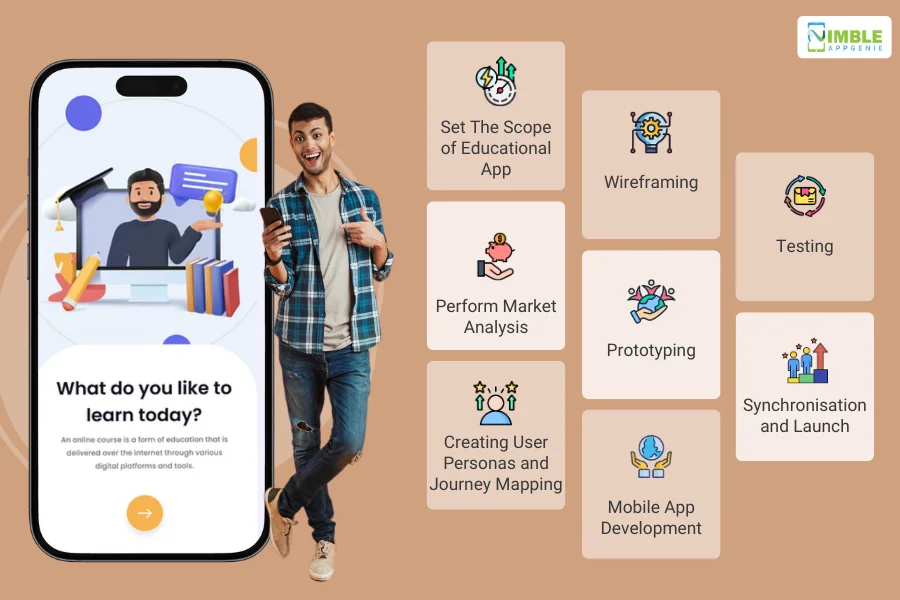
Step 1: Set The Scope of Educational App
This is the prime step where setting the scope and aim for the educational app plays a crucial role. Here you have to set the aim for the app that will define the scope of creating it.
The purpose of designing an online learning app lies behind the reason to develop it. Setting a goal for an app assists in providing clarity and finalizing the end purpose of educational software.
Step 2: Perform Market Analysis
One of the significant points that should be considered is to perform market analysis. Here, significant educational app statistics can help to know the current market dynamics.
It will assist in framing the objectives and identifying the user’s demands with respect to the educational app. Conducting market research can be helpful in knowing competitors’ strategies to frame UI/UX design.
Step 3: Creating User Personas and Journey Mapping
Creating user personas is a step to be followed after conducting a market analysis. Here target user personas are developed based on market demand and current changing preferences parameters.
Later, a user journey map is prepared that will scale up the process of how users will be able to navigate through an educational app.
Step 4: Wireframing
Creating mobile app wireframing helps to prepare a layout for a web page useful to demonstrate interface elements that will exist over the key pages.
It is a kind of preparation strategy for your eLearningapp design where a skeletal framework is prepared showcasing a dummy of the final interface.
Step 5: Prototyping
Mobile app prototyping assists in seeing how the will application look after its complete development. Prototyping refers to an experimental process where design teams implement ideas on a paper.
Here team builds prototypes of various degrees for capturing the interest of users and they test them to identify successful design patterns to develop the design of an educational app.
Step 6: Mobile App Development
Under this process, you need to hire mobile app developers who excel in the skill of creating it successfully. Now, when wireframing and prototyping are final, the backend work is performed.
Based on the database, frameworks, and computer language, developers align the user interface with its operating activities. An experienced mobile app development company can guide you here.
Step 7: Testing
Now, here comes an important step in the process of designing an educational app. Mobile app testing will include a complete test process of design and database frameworks.
Here you need to run a usability test on real users to check the actual output of educational app design. After testing, there is a need to analyze the results and then compare the actual output with the standard result.
Step 8: Synchronisation and Launch
At last, you need to identify errors through testing and should take steps to mitigate the bugs within the app.
You should sync the application with its design and then launch it successfully. A regular check of the user interface is significant for enhancing the overall experience.
After learning the procedure from an educational app design guide, it is crucial to know the factors impacting it. Check out the next heading for the same.
Common Factors Impacting an Educational App Design
Till now, you learned the basics, the importance of good app design, the top popular edtech app design, and the process to perform it successfully.
Now, there are many factors impacting educational app design?
Let’s evaluate them together.
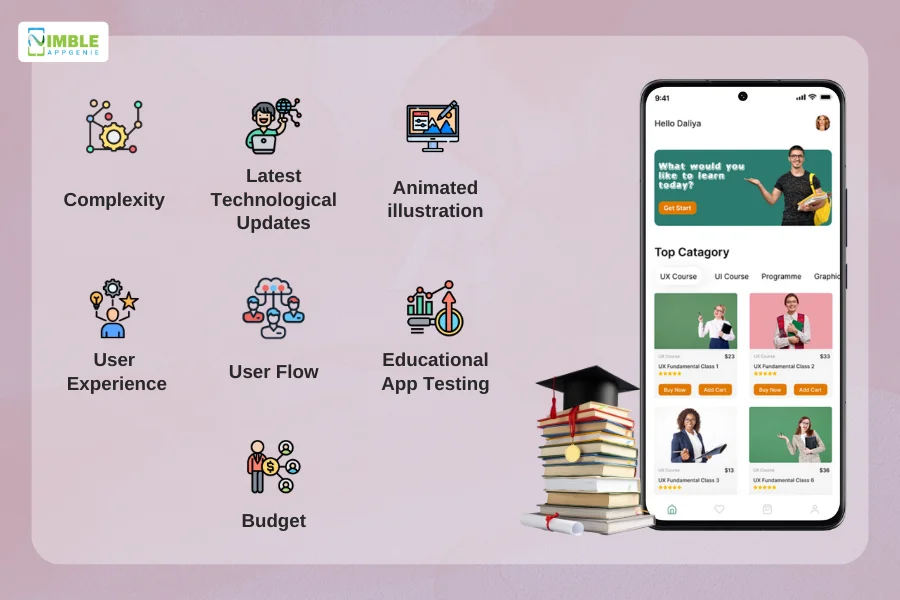
-
Complexity
App complexity and size of an app impact the design implemented to process it. Here complexity refers to critical factors that are paramount while developing an app.
It can range from simple, single-purpose tools to complex and multifunctional platforms. A complicated app design requires additional tools and platforms for successfully developing it.
-
Latest Technological Updates
Technology is a continuously changing field and with every update in technology, app designs change as per users preferences.
Thus, keeping track of the latest technology requires regular market analysis and tools to update designs accordingly. It impacts the latest designs and speed of an educational app.
-
Animated illustration
In the current era, the user interface is impacted through the animations and illustrations and they have turned out to be the best source for delivering effective information.
Animations add a layer of interactivity that helps in engagement. It also assists the users through the app by providing visual feedback and cues that can increase the overall user experience.
-
User Experience
User experience plays a prominent role within the mobile app development process that directly has an impact on the success and performance of an app.
A positive user experience can significantly improve customer engagement and satisfaction. The design of an app is impacted through experience that helps to predict what will happen next.
-
User Flow
Another important component of educational app design is user flow. Here it dictates the logical sequence related to screens and actions.
A poor user flow can impact the complete design process along with the navigation structure, conversion rates, and user interactions.
-
Educational App Testing
It is an important act of checking the performance of software concerning user satisfaction. After identifying the errors and bugs through testing, user performance can be increased.
Along with this, by asking users questions related to the app and their understanding based on problems, you can mitigate errors successfully. A bad testing can result in negative consequences.
-
Budget
Budget plays a major role that impacts the app design. Prior to the budget, the successful allocation of resources impacts the cost of app design.
Your total budget impacts the cost to build an educational app as a high amount may include a more simplified design and vice versa.
These were some of the factors that may impact the overall app design process.
Now, the next question is the cost.
What’s the Cost to Design an Educational App?
Want to know the right cost to design your educational app?
Well, before that you should check out the factors impacting app design in the prior section. One of them is costs, right?
The average cost of educational app design can range from $40,000 to $100,000. The given range is provided to have a cost estimate based on the factors and functionalities.
Apart from the cost, you might require some additional tips to design your educational app. Let’s study them together.
Future Tips for an Educational App Design
After learning about the cost, are you ready to know some tips for enhancing the work processes of your app design?
Well, here you can find them all.
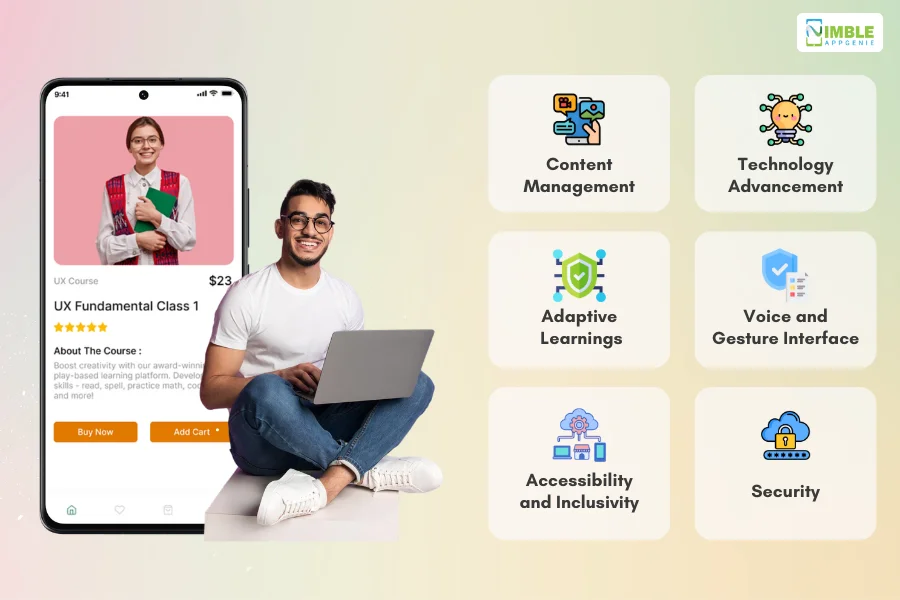
1. Content Management
For designing an app managing your content is important. Here content refers to puzzles and videos along with the gamified elements for making the learning interactive and fun.
Here you should implement appropriate text, images, videos, and audio that can cater to different learning styles for drafting engaging content.
2. Technology Advancement
Multiple technological advancements such as virtual reality, augmented reality along artificial intelligence can open up more opportunities for innovation and creativity.
With the implementation of the latest technologies, you can improve the complete app design process. It can ensure user satisfaction and engagement.
3. Adaptive Learnings
Using algorithms that can provide support and hints to assist the users who find it difficult to use the app can make an imperative user design in the future.
Here you should make the algorithms effective that can be supportive and help users to learn the app along with its navigation features.
4. Voice and Gesture Interface
Using voice commands over the app and hand gestures is another prominent future app design feature to implement within the educational app design.
A creative intuition that assists users in interacting with digital products and services without any traditional input device may affect app design.
5. Accessibility and Inclusivity
One of the important protocols in the current educational app design trend is accessibility for ensuring that the apps are accessible to the content.
Providing a reference point that has made features accessible such as providing alternative text for images and developing adaptable user interfaces can be adopted for interactive app designs.
6. Security
Mobile app security is a prime feature and is not an alternative. Here you should consider ethics by deciding on the app design that can keep users’ data safe and secure.
To ensure app design security, you should be aware of various technologies that can help in maintaining it. Such as encryption, authorization, API security, secure data, and code analysis.
If you want to gather more information related to adopting best practices for educational app design, then connecting with an experienced company can help.
How Can Nimble AppGenie Help in Creating an Educational App?
Finding the right company to design your educational app?
Well, no need to go far. Connect with Nimble AppGenie. With a trusted team of experts, you can develop your educational app with ease.
Our expert panel is ready to help to convert your educational app dream into reality. We are the best educational app development company to help you stand out competitive market.
Conclusion
Before starting with the app design process, the educational app design guide details the basics and reasons why people are after an interactive user interface. Some of the common basics include user experience that deals with user-related needs, typography related to fonts, and responsive app design for speedy response designs.
One of the major reasons behind implementing effective educational app design is to gain user engagement for long intervals. Top popular educational apps including Udemy, and LinkedIn Learning, know the importance of good app designs and implement them for a seamless user experience.
The process of app design starts with conducting market research, developing user personas and journey mappings, wireframing, prototyping, testing, and launch. Tips to follow are the latest educational app design technologies such as AI, AR, or VR. You can connect with an experienced company to know more.
FAQs
The basics of designing an educational app include:
- Clarity: Ensure that the app is free of clutter, with a clean layout that avoids high-contrast colors and complicated fonts.
- User-Centered Design: Focus on understanding and meeting the needs of the users through an iterative design process.
- Intuitive Navigation: Make it easy for users to find the information they need and understand how to use the app.
- Responsive Design: Ensure the app works well on a variety of devices, maintaining optimal usability and appearance.
- Aesthetic Consistency: Keep a consistent style and appearance to help users identify and navigate the app easily.
- Typography: Use appealing typography to capture users’ attention and enhance the overall look and feel of the app.
- App Size: Design the app for easy operation with common features accessible in thumb regions.
- Feedback and Interaction: Implement features that collect and utilize user feedback to improve the app experience.
Good app design is crucial for several reasons:
- Improves Market Presence: Enhances user experience and conversion rates, boosting the app’s market performance.
- First Impression: A well-designed app makes a positive first impression, attracting users to download and use it.
- Competitive Advantage: Provides a superior user experience, setting the app apart from competitors.
- Brand Identity: Consistent and visually appealing design builds a strong brand identity.
- Increases Revenue: Simplifies navigation, fulfilling user demands and increasing sales.
- User Engagement: An attractive UI/UX keeps users engaged over the long term.
- Improves User Interaction: Enhances interaction through personalized content and customized settings.
Here are some popular educational app designs:
- Khan Academy: Uses tools like Camtasia Recorder, SmoothDraw, and Wacom Bamboo Tablet to create an attractive platform.
- Quizlet: Focuses on providing a simple and effective infrastructure and visual design to guide student learning.
- Babbel: Implements cognitive techniques for vocabulary learning with various types of screens like login, home, and statistics screens.
- Udemy: Connects sellers and buyers in the education sector with an interactive user interface.
- Coursera: Engages users with quizzes and a wide variety of learning tools.
- edX: Offers online courses from top universities and companies with a scalable and interactive design.
- LinkedIn Learning: Uses the LIL interface for seamless user experience in skill enhancement and job finding.
- Duolingo: Features a clean, intuitive interface that retains and attracts users with its simplicity.
The process of designing an educational app includes:
- Setting the Scope: Define the app’s aim and purpose.
- Market Analysis: Conduct research to understand market dynamics and user demands.
- Creating User Personas and Journey Mapping: Develop target user personas and map their journey through the app.
- Wireframing: Create a skeletal framework of the app’s interface.
- Prototyping: Build prototypes to visualize the app’s look and functionality.
- Development: Hire skilled developers to create the app based on wireframes and prototypes.
- Testing: Run usability tests to identify and fix issues.
- Synchronization and Launch: Sync the app with its design and launch it successfully, followed by regular checks and updates.
Several factors can impact the design of an educational app:
- Complexity: The complexity and size of the app can affect the design and the tools needed for development.
- Technological Updates: Keeping up with technological advancements is crucial for maintaining an updated and efficient design.
- Animated Illustrations: Animations and illustrations can enhance user engagement and experience.
- User Experience: A positive user experience improves engagement and satisfaction.
- User Flow: The logical sequence of screens and actions impacts navigation and user interaction.
- Software Testing: Thorough testing is essential to identify and fix issues, ensuring a smooth user experience.
- Budget: The budget affects the design, with higher budgets allowing for more sophisticated and simplified designs.
Future tips for designing an educational app include:
- Content Management: Implement interactive elements like puzzles, videos, and gamified content.
- Technology Advancement: Incorporate the latest technologies like VR, AR, and AI for innovative app features.
- Adaptive Learning: Use algorithms to provide support and hints, enhancing the user experience.
- Voice and Gesture Interface: Implement voice commands and hand gestures for intuitive user interaction.
- Accessibility and Inclusivity: Ensure the app is accessible to all users by providing alternative text for images and adaptable interfaces.
- Security: Prioritize user data security with technologies like encryption, authorization, and secure databases.

Niketan Sharma is the CTO of Nimble AppGenie, a prominent website and mobile app development company in the USA that is delivering excellence with a commitment to boosting business growth & maximizing customer satisfaction. He is a highly motivated individual who helps SMEs and startups grow in this dynamic market with the latest technology and innovation.
Table of Contents




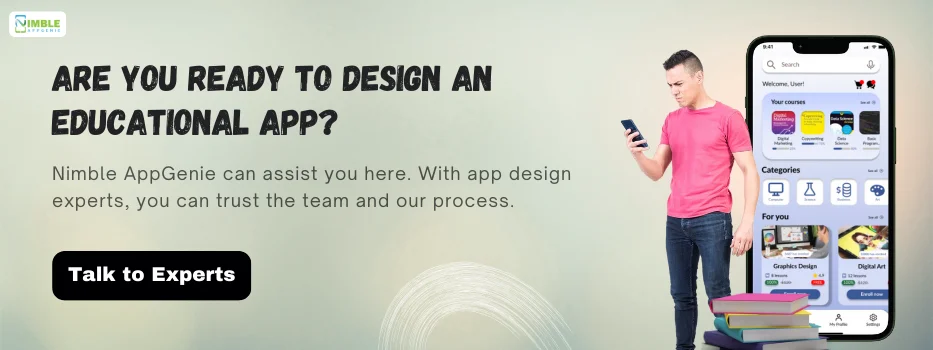
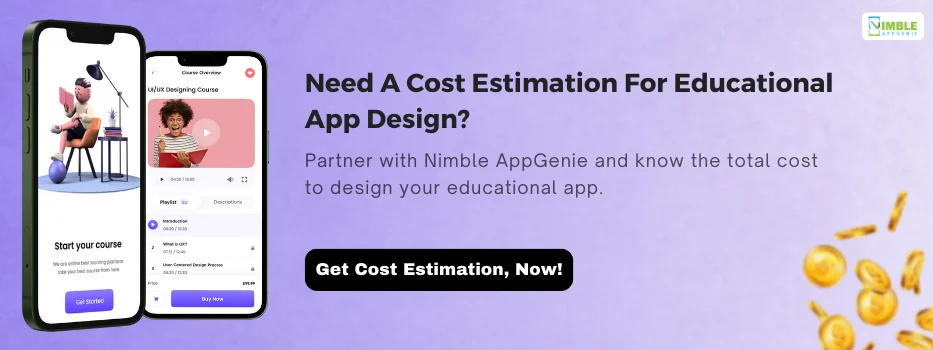
No Comments
Comments are closed.